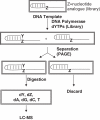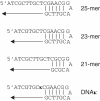A mass spectrometry-based approach for identifying novel DNA polymerase substrates from a pool of dNTP analogues
- PMID: 16945949
- PMCID: PMC1636374
- DOI: 10.1093/nar/gkl632
A mass spectrometry-based approach for identifying novel DNA polymerase substrates from a pool of dNTP analogues
Abstract
There has been a long-standing interest in the discovery of unnatural nucleotides that can be incorporated into DNA by polymerases. However, it is difficult to predict which nucleotide analogs will prove to have biological relevance. Therefore, we have developed a new screening method to identify novel substrates for DNA polymerases. This technique uses the polymerase itself to select a dNTP from a pool of potential substrates via incorporation onto a short oligonucleotide. The unnatural nucleotide(s) is then identified by high-resolution mass spectrometry. By using a DNA polymerase as a selection tool, only the biologically relevant members of a small nucleotide library can be quickly determined. We have demonstrated that this method can be used to discover unnatural base pairs in DNA with a detection threshold of < or =10% incorporation.
Figures






Similar articles
-
Substituent effects on the pairing and polymerase recognition of simple unnatural base pairs.Nucleic Acids Res. 2006 Apr 14;34(7):2037-45. doi: 10.1093/nar/gkl049. Print 2006. Nucleic Acids Res. 2006. PMID: 16617144 Free PMC article.
-
Facile polymerization of dNTPs bearing unnatural base analogues by DNA polymerase alpha and Klenow fragment (DNA polymerase I).Biochemistry. 2003 Sep 9;42(35):10472-81. doi: 10.1021/bi034763l. Biochemistry. 2003. PMID: 12950174
-
Systematic analysis of enzymatic DNA polymerization using oligo-DNA templates and triphosphate analogs involving 2',4'-bridged nucleosides.Nucleic Acids Res. 2008 Aug;36(13):4257-65. doi: 10.1093/nar/gkn404. Epub 2008 Jun 26. Nucleic Acids Res. 2008. PMID: 18583360 Free PMC article.
-
Unnatural base pair systems for sensing and diagnostic applications.Expert Rev Mol Diagn. 2011 Apr;11(3):321-31. doi: 10.1586/erm.11.5. Expert Rev Mol Diagn. 2011. PMID: 21463241 Review.
-
Recent progress in dissecting molecular recognition by DNA polymerases with non-native substrates.Curr Opin Chem Biol. 2017 Dec;41:43-49. doi: 10.1016/j.cbpa.2017.10.005. Epub 2017 Nov 2. Curr Opin Chem Biol. 2017. PMID: 29096323 Free PMC article. Review.
Cited by
-
Discovery, characterization, and optimization of an unnatural base pair for expansion of the genetic alphabet.J Am Chem Soc. 2008 Feb 20;130(7):2336-43. doi: 10.1021/ja078223d. Epub 2008 Jan 25. J Am Chem Soc. 2008. PMID: 18217762 Free PMC article.
-
Solution structure, mechanism of replication, and optimization of an unnatural base pair.Chemistry. 2010 Nov 8;16(42):12650-9. doi: 10.1002/chem.201000959. Chemistry. 2010. PMID: 20859962 Free PMC article.
References
-
- Doublie S., Sawaya M.R., Ellenberger T. An open and closed case for all polymerases. Structure. 1999;7:R31–R35. - PubMed
-
- Jager J., Pata J.D. Getting a grip: polymerases and their substrate complexes. Curr. Opin. Struct. Biol. 1999;9:21–28. - PubMed
-
- Chiaramonte M., Moore C.L., Kincaid K., Kuchta R.D. Facile polymerization of dNTPs bearing unnatural base analogues by DNA polymerase alpha and Klenow fragment (DNA polymerase I) Biochemistry. 2003;42:10472–10481. - PubMed

